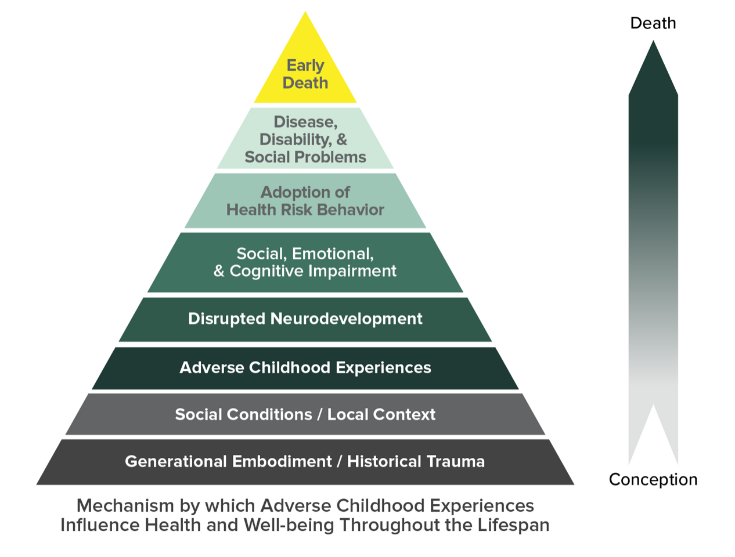
Childhood Trauma and Its Impact on Health

If you’ve lived through traumatic experiences, you may hear the phrase, “It’s not you but what happened to you.” That’s because trauma can impact thoughts, emotions, behaviors, and interactions with others. However, the relationship between childhood trauma and health is often overlooked.
October 25, 2023
Approximately 64% of adults in the United States have experienced at least one kind of adverse childhood experience (ACE) before age 18, while nearly 1 in 6 report experiencing four or more, according to the Centers for Disease Control and Prevention. Those who experience four or more adverse experiences during childhood are at significantly higher risk of developing chronic health problems and serious mental illness.
Read about how Penn State Health is helping teachers and others support children who have undergone trauma.
Adverse Childhood Experiences (ACEs)
ACEs are potentially traumatic events, like abuse, neglect, or exposure to household dysfunction, that can have strong effects on a person’s health. The ACEs Aware initiative has a questionnaire with experiences that correspond to potentially traumatic events, such as:
 Abuse – physical, emotional, or sexual
Abuse – physical, emotional, or sexual- Neglect – physical or emotional
- Household dysfunction – parent mental illness, incarcerated relative, domestic violence, substance abuse within the home, not being raised by both biological parents
Those completing the ACE questionnaire and indicating four or more of these experiences during childhood tend to have an increased risk of developing long-term health conditions, including heart disease, stroke, cancer, chronic obstructive pulmonary disease, diabetes, and Alzheimer’s disease.
Risk Factors for Adverse Childhood Experiences
The Centers for Disease Control and Prevention identifies numerous factors that contribute to the risk of an ACE exposure. Some individual and family risk factors include:
- Low income
- Adults with low levels of education
- Children and youth who are socially isolated or with friends who engage in aggressive or delinquent behavior
Community-related risk factors can include:
- High rates of violence and/or crime
- High rates of poverty and limited educational/economic opportunity
- Unstable housing
- Frequent food insecurity
In addition, a study found that some populations have a higher risk of exposure to ACEs, including members of the LGTBQIA+ community and those who identify as female, Black, Hispanic, or multiracial.
Adverse Childhood Trauma as a Health Equity Issue
The risk factors for ACEs involve all five social determinants of health and are more likely to affect marginalized communities. The cycle of childhood trauma and its lifelong effects can create further inequities within populations already experiencing major inequalities. Stressful events may have lasting effects, and exposure to crime and violence in the home significantly influences health across various populations.
Health disparities can also result from biologic responses to trauma that are passed down through genetics (called epigenetics), illustrating the power of the environment, the long-term effects of trauma, and how traumatic events may make it difficult to manage overall health.
Exposure to childhood trauma, health disparities, and social determinants of health are inseparable.
Addressing Childhood Trauma
While we cannot control the environments our patients come from or create jobs for them, health care professionals can make a difference. By understanding the impact of childhood trauma, they can improve their approach to patient care.
- For pediatric patients: Screening for ACEs offers an opportunity to connect families with resources they need to reduce certain risk factors.
- For adults: ACE screening can provide insight into past trauma that may be affecting them today.
As a health care organization, Penn State Health is in a unique position to provide care and help address the factors that influence people to seek care. An awareness of ACEs will not solve everything, but it’s a crucial starting point to understand our patients better.
Additional Resources
Learn ways to incorporate ACEs into your workflow from a health equity perspective. Contact Heather Doyle, program director for health equity, at hdoyle@pennstatehealth.psu.edu.
SDGs, Targets, and Indicators Analysis
1. Which SDGs are addressed or connected to the issues highlighted in the article?
- SDG 3: Good Health and Well-being
- SDG 4: Quality Education
- SDG 5: Gender Equality
- SDG 10: Reduced Inequalities
The article discusses the impact of childhood trauma on health, which is directly related to SDG 3. It also mentions the importance of supporting children who have undergone trauma, which is connected to SDG 4. The article highlights that certain populations, such as the LGBTQIA+ community and marginalized communities, have a higher risk of exposure to adverse childhood experiences, indicating a connection to SDG 5. Additionally, the article emphasizes that childhood trauma and its lifelong effects can create further inequities within populations, aligning with SDG 10.
2. What specific targets under those SDGs can be identified based on the article’s content?
- Target 3.4: By 2030, reduce by one-third premature mortality from non-communicable diseases through prevention and treatment and promote mental health and well-being.
- Target 4.7: By 2030, ensure that all learners acquire the knowledge and skills needed to promote sustainable development, including among others through education for sustainable development and sustainable lifestyles, human rights, gender equality, promotion of a culture of peace and non-violence, global citizenship and appreciation of cultural diversity and of culture’s contribution to sustainable development.
- Target 5.2: Eliminate all forms of violence against all women and girls in the public and private spheres, including trafficking and sexual and other types of exploitation.
- Target 10.2: By 2030, empower and promote the social, economic and political inclusion of all, irrespective of age, sex, disability, race, ethnicity, origin, religion or economic or other status.
Based on the article’s content, the specific targets identified are related to reducing premature mortality from non-communicable diseases (Target 3.4), promoting education for sustainable development and gender equality (Target 4.7), eliminating violence against women and girls (Target 5.2), and promoting social, economic, and political inclusion (Target 10.2).
3. Are there any indicators mentioned or implied in the article that can be used to measure progress towards the identified targets?
- Indicator 3.4.1: Mortality rate attributed to cardiovascular disease, cancer, diabetes, or chronic respiratory disease.
- Indicator 4.7.1: Extent to which (i) global citizenship education and (ii) education for sustainable development are mainstreamed in (a) national education policies; (b) curricula; (c) teacher education; and (d) student assessment.
- Indicator 5.2.1: Proportion of ever-partnered women and girls aged 15 years and older subjected to physical, sexual, or psychological violence by a current or former intimate partner in the previous 12 months.
- Indicator 10.2.1: Proportion of people living below 50 percent of median income, by age, sex, and persons with disabilities.
The article does not explicitly mention indicators, but based on the identified targets, the indicators mentioned above can be used to measure progress towards those targets. These indicators measure mortality rates attributed to non-communicable diseases (Indicator 3.4.1), the integration of global citizenship education and education for sustainable development in national policies and curricula (Indicator 4.7.1), the prevalence of violence against women and girls (Indicator 5.2.1), and the proportion of people living below a certain income threshold (Indicator 10.2.1).
4. Table: SDGs, Targets, and Indicators
| SDGs | Targets | Indicators |
|---|---|---|
| SDG 3: Good Health and Well-being | Target 3.4: By 2030, reduce by one-third premature mortality from non-communicable diseases through prevention and treatment and promote mental health and well-being. | Indicator 3.4.1: Mortality rate attributed to cardiovascular disease, cancer, diabetes, or chronic respiratory disease. |
| SDG 4: Quality Education | Target 4.7: By 2030, ensure that all learners acquire the knowledge and skills needed to promote sustainable development, including among others through education for sustainable development and sustainable lifestyles, human rights, gender equality, promotion of a culture of peace and non-violence, global citizenship and appreciation of cultural diversity and of culture’s contribution to sustainable development. | Indicator 4.7.1: Extent to which (i) global citizenship education and (ii) education for sustainable development are mainstreamed in (a) national education policies; (b) curricula; (c) teacher education; and (d) student assessment. |
| SDG 5: Gender Equality | Target 5.2: Eliminate all forms of violence against all women and girls in the public and private spheres, including trafficking and sexual and other types of exploitation. | Indicator 5.2.1: Proportion of ever-partnered women and girls aged 15 years and older subjected to physical, sexual, or psychological violence by a current or former intimate partner in the previous 12 months. |
| SDG 10: Reduced Inequalities | Target 10.2: By 2030, empower and promote the social, economic and political inclusion of all, irrespective of age, sex, disability, race, ethnicity, origin, religion or economic or other status. | Indicator 10.2.1: Proportion of people living below 50 percent of median income, by age, sex, and persons with disabilities. |
Behold! This splendid article springs forth from the wellspring of knowledge, shaped by a wondrous proprietary AI technology that delved into a vast ocean of data, illuminating the path towards the Sustainable Development Goals. Remember that all rights are reserved by SDG Investors LLC, empowering us to champion progress together.
Source: pennstatehealthnews.org

Join us, as fellow seekers of change, on a transformative journey at https://sdgtalks.ai/welcome, where you can become a member and actively contribute to shaping a brighter future.






